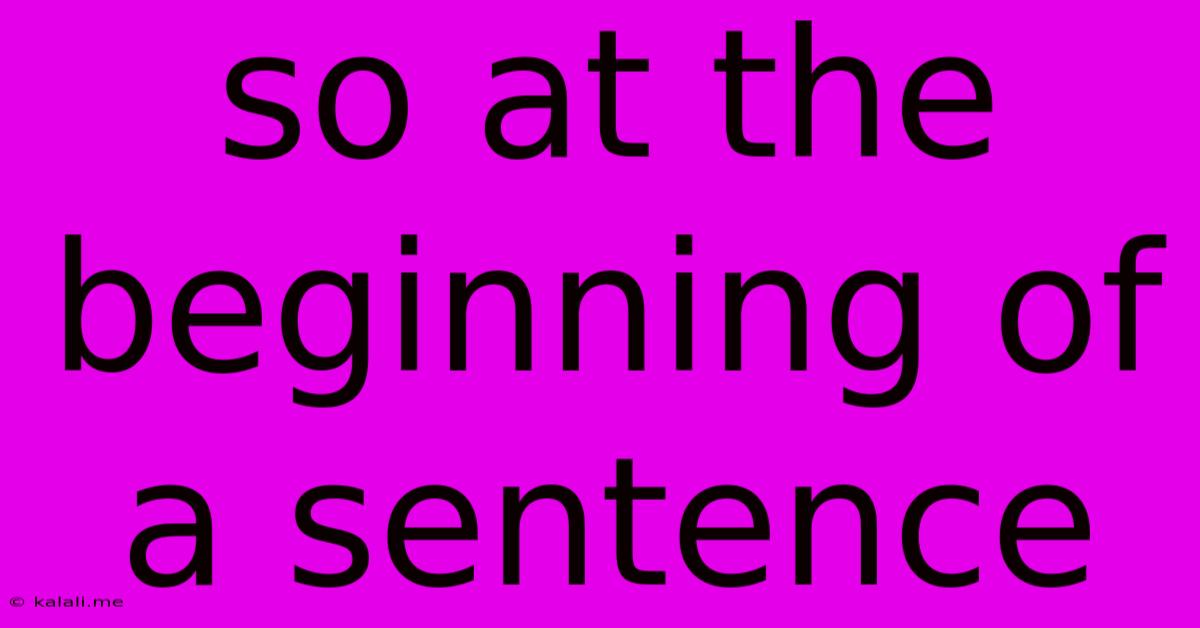So At The Beginning Of A Sentence
Kalali
May 21, 2025 · 3 min read

Table of Contents
So at the Beginning of a Sentence: When It's Okay and When It's Not
So, you're writing a sentence and you're thinking, "Should I start with 'so'?" This seemingly simple word can be a stylistic minefield. While generally discouraged in formal writing, 'so' at the beginning of a sentence has its place, and understanding its nuances is key to crafting clear and effective prose. This guide will explore when it's acceptable and when it's best to avoid this word at the start of your sentence.
When "So" Works at the Beginning of a Sentence
There are specific contexts where beginning a sentence with "so" isn't just acceptable but can even enhance the flow and readability of your writing. These situations generally involve informal writing styles or specific rhetorical effects:
-
Showing Cause and Effect: When "so" clearly indicates a consequence or result of a previously stated idea, it's perfectly fine. For example:
- "The rain poured down. So, we decided to stay inside." Here, "so" acts as a concise connector, showing the direct relationship between the rain and the decision.
-
Summarizing or Concluding: "So" can effectively summarize preceding information or draw a conclusion.
- "We weighed the pros and cons, researched different options, and consulted experts. So, the final decision was to proceed with plan A." This usage is clear and natural.
-
Informal Writing: In casual conversations, blog posts (like this one!), or other informal writing, starting sentences with "so" is far more acceptable. It lends a conversational tone that can be engaging for readers.
- "So, that's the story of how I met my dog." The informality fits the context.
-
Emphasis and Transition: Sometimes, "so" can add emphasis or create a smoother transition between ideas.
- "The evidence was overwhelming. So, there was no doubt about the culprit's guilt." The "so" emphasizes the conclusion.
When to Avoid "So" at the Beginning of a Sentence
While there are valid uses, starting sentences with "so" is frequently frowned upon in formal writing, such as academic papers, business reports, or legal documents. This is because:
-
It can sound informal and even childish: In more formal contexts, it can detract from the professionalism of your writing.
-
It can be vague: Without proper context, "so" can leave the reader wondering what it's referring to. This vagueness undermines clarity.
-
Overuse weakens writing: Relying too heavily on "so" to begin sentences creates a repetitive and monotonous rhythm.
Alternatives to Starting with "So"
If you find yourself tempted to start a sentence with "so," consider these alternatives:
- Therefore: More formal and precise than "so."
- Consequently: Similar to "therefore," suggesting a logical consequence.
- Thus: A concise and formal way to indicate a result.
- Hence: Another formal option, implying a logical deduction.
- As a result: A clearer and more descriptive alternative.
- Accordingly: Suggests a response or action based on previous information.
Conclusion: Mastering the "So"
Knowing when to use "so" at the beginning of a sentence involves understanding your audience and the level of formality required. While it's acceptable and even preferable in many informal contexts, formal writing often benefits from more precise and sophisticated transitional words. By learning to use "so" judiciously and strategically choosing alternatives when needed, you can achieve clarity, style, and a polished writing voice.
Latest Posts
Latest Posts
-
How To Eliminate Fireplace Smoke Odor In House
May 21, 2025
-
How To Get Missions Gta 5
May 21, 2025
-
How Long For Cement To Dry Before Rain
May 21, 2025
-
Why Do Horses Paw The Ground
May 21, 2025
-
What Are The Sills On A Car
May 21, 2025
Related Post
Thank you for visiting our website which covers about So At The Beginning Of A Sentence . We hope the information provided has been useful to you. Feel free to contact us if you have any questions or need further assistance. See you next time and don't miss to bookmark.